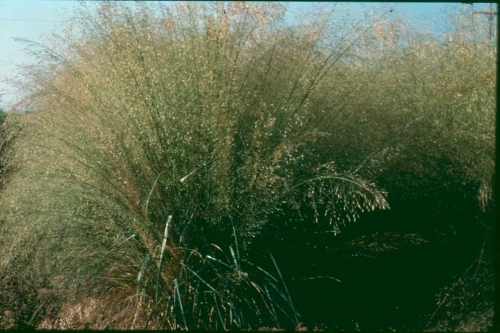About Grasses | Map | Plant List/Information | Ornamental Grass Preference Trial
Grasses of Maxwell Arboretum
Grasses are a great addition to any landscape. They add form, texture, structure, fall color and winter interest. In addition to all the native species growing in the Prairie, the following grasses can be found in the Yeutter Garden and Fleming Slope:
Miscanthus sinensis –Morning Light– 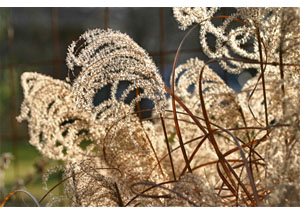
Morning Light Japanese Silver Grass
4–5–
the premier cultivar of the species
silver white midrib
pink–bronze flowers in early fall, lighten to almost white
great seed heads that last through winter and are often used in dried arrangements
best in full sun, not as tall in part shade
cultivated in Japan for a century, introduced to the west in 1976
elegant
RHS Award of Garden Merit, 2001
Miscanthus sinensis –Rotsilber–
Rotsilber Japanese Silver Grass
Around 4–
flowers in September, flowerheads red turning to silver
foliage turns coppery red in fall
great seedheads that last through winter and are used in dried arrangements
elegant
great fall color
Raised by renowned breeder Ernst Pagels in Leer, Germany
(Mr. Pagels was awarded the Reginald Cory Memorial Cup by the RHS for his work with Miscanthus)
Link to the Royal Botanical Society's Miscanthus Bulletin with results of their extensive trials and recipients of the Award of Garden Merit—a great resource.
Schizachyrium scoparium 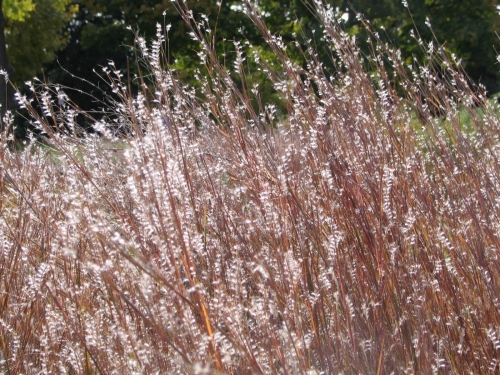
Little Bluestem
2–3–
iconic native prairie grass
full sun
wonderful seedheads, especially when sited so backlit by the sun
beautiful fall color
what Willa Cather was referring to when she wrote about the –shaggy red grass"
no eastern Nebraska garden should be without it
some of the arboretum–s plants are the cultivar –Blaze–
Eragrostis trichodes
Sand Lovegrass
2–4–
full sun
prefers well–drained soils, the plants on Yeutter Berm may be shorter than
average due to their somewhat wet, not wonderfully drained site.
The weight of their flowers can make them a little floppy—
Yeutter–s plants may be more so due again to their wetter than preferred site.
Pinkish tan blooms in July and August
wonderful airy inflorescences and seed heads
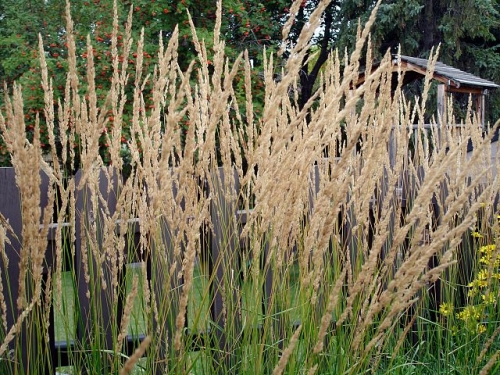 Calamagrostis × acutiflora 'Karl Foerster'
Calamagrostis × acutiflora 'Karl Foerster'
Karl Foerster Feather Reed Grass
To 6– with inflorescences
Will tolerate clay soils and light shade
Natural hybrid of C. epigejos and C. arundinacea (marketed as –Stricta– in the past)
A strong tightly vertical upright form in the landscape, won–t flop
2001 Perennial Plant of the Year, see http://www.perennialplant.org/ppy/01ppy.html
almost no maintenance, just cut back in the spring
(do this early, Calamagrostis is a cool season grass and will green up quickly)
flower plumes pinkish to start turning tan, great for dried arrangements
blooms in June
provides motion in the garden
Image: Daryl Mitchell, Saskatoon, Saskatchewan
Bouteloua curtipendula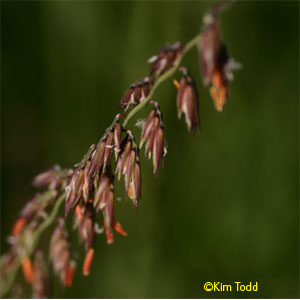
Sideoats Grama
2–3–
bluish green, turning reddish–brown to straw in the fall
blooms July–August, oat–like spikes
full sun
will tolerate clay soils
a great native grass
fine textured
native
Bouteloua gracilis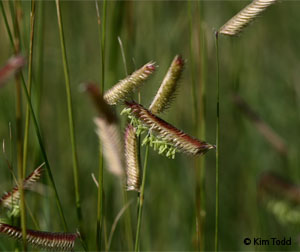
Blue Grama
15–
prefers dry soils
mid summer bloom, interesting –eye–brow,– fun for kids, long lasting
good fall color
best in masses
native
Neb guide
Rhs misc trial
books
